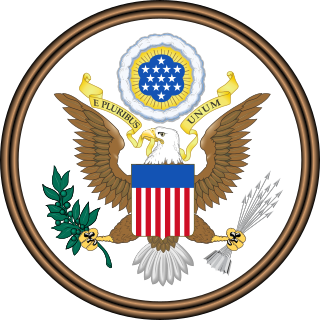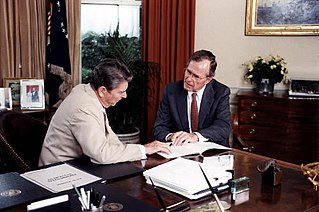In United States government, the line-item veto, or partial veto, is the power of an executive authority to nullify or cancel specific provisions of a bill, usually a budget appropriations bill, without vetoing the entire legislative package. The line-item vetoes are usually subject to the possibility of legislative override as are traditional vetoes.
Reno v. American Civil Liberties Union, 521 U.S. 844 (1997), was a landmark decision of the Supreme Court of the United States, unanimously ruling that anti-indecency provisions of the 1996 Communications Decency Act violated the First Amendment's guarantee of freedom of speech. This was the first major Supreme Court ruling on the regulation of materials distributed via the Internet.
In legislative procedure, a rider is an additional provision added to a bill or other measure under the consideration by a legislature, which may or may not have much, if any, connection with the subject matter of the bill.
City of Boerne v. Flores, 521 U.S. 507 (1997), was a landmark decision of the Supreme Court of the United States concerning the scope of Congress's power of enforcement under Section 5 of the Fourteenth Amendment. The case also had a significant impact on historic preservation.

Separation of powers is a political doctrine originating in the writings of Charles de Secondat, Baron de Montesquieu in The Spirit of the Laws, in which he argued for a constitutional government with three separate branches, each of which would have defined authority to check the powers of the others. This philosophy heavily influenced the United States Constitution, according to which the Legislative, Executive, and Judicial branches of the United States government are kept distinct in order to prevent abuse of power. The American form of separation of powers is associated with a system of checks and balances.
Clinton v. City of New York, 524 U.S. 417 (1998), was a landmark decision by the Supreme Court of the United States in which the Court held, 6–3, that the line-item veto, as granted in the Line Item Veto Act of 1996, violated the Presentment Clause of the United States Constitution because it impermissibly gave the President of the United States the power to unilaterally amend or repeal parts of statutes that had been duly passed by the United States Congress. Justice John Paul Stevens wrote for the six-justice majority that the line-item veto gave the President power over legislation unintended by the Constitution, and was therefore an overstep in their duties.
Immigration and Naturalization Service v. Chadha, 462 U.S. 919 (1983), was a United States Supreme Court case ruling in 1983 that the one-house legislative veto violated the constitutional separation of powers.
The legislative veto was a feature of dozens of statutes enacted by the United States federal government between approximately 1930 and 1980, until held unconstitutional by the U.S. Supreme Court in INS v. Chadha (1983). It is a provision whereby Congress passes a statute granting authority to the President and reserving for itself the ability to override, through simple majority vote, individual actions taken by the President pursuant to that authority.
Impoundment is an act by a President of the United States of not spending money that has been appropriated by the U.S. Congress. Thomas Jefferson was the first president to exercise the power of impoundment in 1801. The power was available to all presidents up to and including Richard Nixon, and was regarded as a power inherent to the office, although one with limits. The Congressional Budget and Impoundment Control Act of 1974 was passed in response to the abuse of power under President Nixon. The Act removed that power, and Train v. City of New York, closed potential loopholes in the 1974 Act. The president's ability to indefinitely reject congressionally approved spending was thus removed.

The Line Item Veto ActPub. L. 104–130 (text)(PDF) was a federal law of the United States that granted the President the power to line-item veto budget bills passed by Congress, but its effect was brief as the act was soon ruled unconstitutional by the Supreme Court in Clinton v. City of New York.

Thomas Francis Hogan is a Senior United States district judge of the United States District Court for the District of Columbia, who served as director of the Administrative Office of the United States Courts from October 17, 2011, until June 30, 2013.
Printz v. United States, 521 U.S. 898 (1997), was a United States Supreme Court case in which the Court held that certain interim provisions of the Brady Handgun Violence Prevention Act violated the Tenth Amendment to the United States Constitution.
The Presentment Clause of the United States Constitution outlines federal legislative procedure by which bills originating in Congress become federal law in the United States.

A signing statement is a written pronouncement issued by the President of the United States upon the signing of a bill into law. They are usually printed in the Federal Register's Compilation of Presidential Documents and the United States Code Congressional and Administrative News (USCCAN). The statements offer the president's view of the law or laws created by the bill.
Kimel v. Florida Board of Regents, 528 U.S. 62 (2000), was a US Supreme Court case that determined that the US Congress's enforcement powers under the Fourteenth Amendment to the US Constitution did not extend to the abrogation of state sovereign immunity under the Eleventh Amendment over complaints of discrimination that is rationally based on age.

William Orton was an American Democratic politician who served as a member of the United States House of Representatives from Utah from 1991 to 1997.
Nevada Department of Human Resources v. Hibbs, 538 U.S. 721 (2003), was a United States Supreme Court case which held that the Family and Medical Leave Act of 1993 was "narrowly targeted" at "sex-based overgeneralization" and was thus a "valid exercise of [congressional] power under Section 5 of the Fourteenth Amendment."
The line-item veto, also called the partial veto, is a special form of veto power that authorizes a chief executive to reject particular provisions of a bill enacted by a legislature without vetoing the entire bill. Many countries have different standards for invoking the line-item veto if it exists at all. Each country or state has its own particular requirement for overriding a line-item veto.
The constitutional law of the United States is the body of law governing the interpretation and implementation of the United States Constitution. The subject concerns the scope of power of the United States federal government compared to the individual states and the fundamental rights of individuals. The ultimate authority upon the interpretation of the Constitution and the constitutionality of statutes, state and federal, lies with the Supreme Court of the United States.

In the United States, the president can use the veto power to prevent a bill passed by the Congress from becoming law. Congress can override the veto by a two-thirds vote of both chambers.






